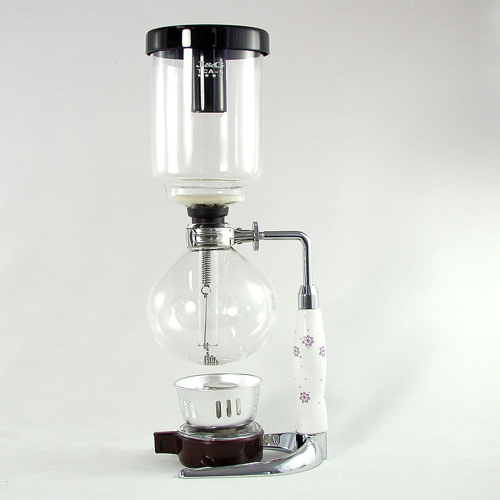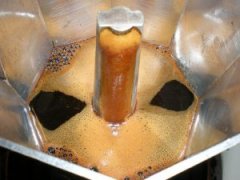Coffee utensils siphon pot favorite of coffee fans

Using the siphon principle, the boiling water is made into coffee powder and stewed to produce the original flavor of coffee. Suitable for coffee: slightly sour, medium mellow coffee grindability: slightly thicker than powder, close to special fine granulated sugar. Siphon coffee, which turns the living room into cafe siphon coffee, is a favorite of many coffee fans. Some people say that because it can extract the most perfect part of coffee, especially the coffee beans with that kind of refreshing and bright acid, and the acid has a mellow flavor, siphon cooking can give full play to the characteristics of this kind of coffee.
There are also many people who like the precision of siphon cooking with a little laboratory flavor. Watching the water rise as the water boils, the coffee extracted into black drops, step by step in the hands of the coffee maker. Using an Italian coffee machine often leaves part of the process to a machine, and siphon coffee seems to satisfy some people who like do-it-yourself DIY.
In 1840, a glass test tube in a laboratory triggered the invention of the siphon coffee maker (Syphon). The British took the test tube used in Biya's chemical experiment as a model to create the first vacuum coffee pot. Two years later, Mrs. Bachang of France improved the kettle with a little spring in shape, and the familiar upper and lower convection siphon pot was born.
The siphon coffee maker lived in France for a long time, but never got a good chance to be very popular.
It became popular for the first time when it was brought to Denmark and Japan in the mid-20th century.
The Japanese like the "tortoise hair" personality of the siphon pot technology standard, carefully deliberating the complex relationship between the size of coffee powder, water and time to mobilize the whole army, and develop a well-regulated coffee path.
The aestheticist Danes focused on functional design, Peter, who imported siphon pots from France in the mid-1950 s. Bolton (Peter Bodum), who thought French-made pots were expensive and difficult to use, partnered with architect Kaas Klaeson to develop Bodum's first styling siphon pot, which went public under the name "Santos".
Siphon coffee maker always has a hint of mystery in most people's impression. Siphon coffee maker plays an important role in the history of coffee development in Taiwan. In recent years, so-called ground coffee (Italian espresso) has become very popular. In comparison, this siphon coffee maker requires higher technology and more cumbersome procedures. In today's industrial and commercial society, there is a tendency to decline gradually, but the mellow flavor of coffee brewed by siphon coffee pot can not be compared with ground coffee brewed by machine.
Most people often have little knowledge of it, or even have the wrong impression, there are usually two extreme views, one is that some people are cautious and frightened about it, and what about the other? It is thought that using a siphon coffee maker is nothing more than boiling the water and stirring the coffee powder; in addition, some people think that the siphon coffee pot looks very dangerous, but as long as it is improperly used, every method of brewing coffee has hidden dangers.
The method of brewing coffee in a siphon pot
Prepare supplies
A set of siphon pots, industrial alcohol, lighters, bamboo spoons for mixing, dry wet rags
Process
First, fill the water-hook the filter element
Fill the pot with hot water and mark it with the "two cups" icon. Put the filter element into the pot, hold the end of the chain with your hand, and gently hook it to the end of the glass tube. Be careful not to release the hook suddenly, so as not to damage the glass tube of the pot.
Second, ignite-insert the pot diagonally-waiting for big bubbles
Light the alcohol lamp and insert the upper pot obliquely so that the rubber edge is pressed against the spout of the next pot (rest assured that the upper pot will not fall off) so that the chain is soaked in the water. Then boil the water and wait for the pot to produce continuous bubbles. Just put the upper pot diagonally, don't let it clog the next pot, small bubbles don't count, wait for big bubbles to appear.
Third, upright-insert it into the upper pot
When large bubbles appear continuously in the lower pot, straighten the upper pot, shake it left and right and press it down slightly so that it is gently stuffed into the lower pot. After the upper pot is plugged in, you can see that the water in the next pot begins to climb up. If you have a bean grinder, you can start grinding beans now! Two cups of water use a medium grinding scale of three spoonfuls of coffee (about 24g)
Fourth, let the water in the lower pot rise completely to the upper pot.
After the water has completely risen to the pot, don't worry, wait a few seconds, and then prepare to pour in the coffee powder after the bubbles in the pot decrease a little.
Fifth, pour in the coffee powder-stir (left and right)
Pour in the ground coffee powder and move it around with a bamboo spoon to evenly remove the coffee powder into the water. The timing starts at the same time as the first stirring.
Stir gently to avoid violent stirring. If it is fresh coffee powder, it will float on the surface to form a layer of powder. At this time, the coffee powder needs to be stirred so that the flavor of the coffee can be completely extracted. The correct stirring action is to move the bamboo spoon in the left and right direction, with a "strong way" of downward pressure, to "press" the coffee powder floating on the surface of the water below the surface.
6. Stir twice more.-flameout
After the first stirring, time 30 seconds, make the second stirring, and then time 20 seconds for the final stirring-- the alcohol lamp can be removed. Take the pre-prepared (wrung-dry) slightly wet dishcloth and gently wrap the side of the lower pot from the side to prevent the wet cloth from touching the place where the alcohol flame at the bottom of the pot comes into contact, so as to prevent the pot from breaking. At this time, you can see that the water in the upper pot is quickly "pulled" to the lower pot. If your coffee is fresh enough, there will be a lot of light brown foam in the pot.
VII. Completion
After the coffee is sucked into the lower pot, hold the upper pot in one hand and the handle of the lower pot in the other, gently shake the upper pot to the left and right to pull out the upper pot and the lower pot. Pour the coffee into a warm coffee cup and enjoy the mellow coffee that you have prepared by hand.
- Prev

Choice of coffee cups
Coffee cup exquisite-* ● Coffee cup exquisite material ceramic cup simple, and porcelain cup round, respectively, mark different coffee attitude. Pottery cup: rich texture, suitable for deep roasting and strong taste of coffee. Porcelain cup: the most common, can be just the interpretation of coffee delicate mellow. Among them, bone china coffee cups made of high-grade porcelain clay and mixed animal bone powder are light in texture and color.
- Next

Coffee utensils Mocha pot Classic appreciation of Bilody Bialetti
Mocha pot provides all families with a simple and convenient choice for making espresso. It is not too much to call BIALETTI the father of mocha pot. Let's take a look at the classic Bilody Bialetti mocha pot. Traditional octagonal mocha pot, lovely DAMA mocha pot. There are more close-ups of Bialetti mocha pots than Letty. Classic Mocha Pot appreciation of Bilody Bialetti 8 Moka Pot Sutra
Related
- What is the Philharmonic pressure? How to use Philharmonic pressure to make delicious coffee
- Why does a hand grinder have more fine powder than an electric grinder?
- In addition to the hot mom, what is the difference between the versions of EK43 | ditting and Mahdi ek43?
- What kind of equipment do you need to make coffee by hand? Introduction to novice starter cooking equipment tools
- Espresso needs to be ground how thick and thin scale entry Italian Coffee Machine Bean Grinder investigation and Grinding course
- How much does it cost to open a small private cafe? How much does it cost to learn coffee? How to operate it?
- The difference between the flavor characteristics of hand-brewed coffee and coffee maker is hand-brewed coffee really better than coffee maker? Can I use a coffee machine to make coffee beans by hand?
- The difference between 01 and 02 of hario v60 filter cup what is the difference between 01 and 02 filter cup opening and cooking flavor
- What's the difference between the smart cup and the French kettle? Which is better, the French kettle or the Smart Cup?
- What's the difference between a smart cup and a V60 filter cup? The difference between the taste of smart cup and hand-brewed coffee

